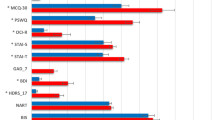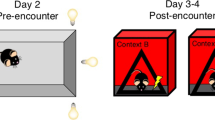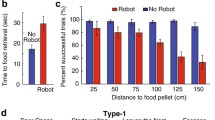Abstract
An anxiety/defense test battery was designed to assess defensive reactions of laboratory rats to situations associated with nonpainful threat (exposure to a cat). The battery measured three defense patterns, movement inhibition, risk assessment behaviors, and inhibition of nondefensive behaviors, in two tasks. Diazepam (4.0 mg/kg) altered four of five risk assessment measures, but failed to show an anxiolytic effect on movement inhibition, and had minimal and inconsistent effects on inhibition of nondefensive behaviors. The risk assessment changes with diazepam were all consistent with an anxiolytic action of diazepam. These results provide a partial contrast to the general lack of anxiolytic action of diazepam in a fear/defense test battery designed to measure reactions to a discrete, present, threat stimulus, and suggest a greater diazepam effect on risk assessment than on other aspects of defensive responding. Sex differences indicating higher defensiveness for female than male rats were obtained on many of these measures.
Similar content being viewed by others
References
Barlow DH (1988) Anxiety and its disorders: the nature and treatment of anxiety and panic. Guilford Press, New York
Blanchard RJ, Blanchard DC (1969) Crouching as an index of fear. J Comp Physiol Psychol 67:370–375
Blanchard RJ, Blanchard DC (1971) Defensive reactions in the albino rat. Learn Motiv 21:351–362
Blanchard DC, Blanchard RJ (1972a) Innate and conditioned reactions to threat in rats with amygdaloid lesions. J Comp Physiol Psychol 81:281–290
Blanchard RJ, Blanchard DC (1972b) Effects of hippocampal lesions on the rat's reaction to a cat. J Comp Physiol Psychol, 78:77–82
Blanchard DC, Blanchard RJ (1988) Ethoexperimental approaches to the biology of emotion. Annual Review of Psychology, Annual Reviews, Palo Alto
Blanchard RJ, Blanchard DC (1989) Anti-predator defensive behaviors in a visible burrow system. J Comp Psychol 103:70–82
Blanchard RJ, Kleinschmidt CF, Fukunaga-Stinson C, Blanchard DC (1980) Defensive attack behavior in male and female rats. Anim Learn Behav 8:177–183
Blanchard RJ, Blanchard DC, Flannelly KJ, Hori K (1986a) Ethanol changes patterns of defensive behavior in wild rats. Physiol Behav 38:645–650
Blanchard RJ, Flannelly KJ, Blanchard DC (1986b) Defensive behaviors of laboratory and wildRattus norvegicus. J Comp Psychol 100:101–107
Blanchard DC, Rodgers RJ, Hori K, Hendrie CA (1988) “Taming” of wild rats(Rattus) by 5-HT1A agonists buspirone and gepirone. Pharm Biochem Behav 31:269–278
Blanchard RJ, Blanchard DC, Hori K (1989a) Ethoexperimental approaches to the study of defensive behavior. In: Blanchard RJ, Brain PF, Blanchard DC, Parmigiani S (eds) Ethoexperimental approaches to the study of behavior. Kluwer Academic, Dordrecht, pp 114–136
Blanchard DC, Rodgers RJ, Hori K, Hendrie CA, Blanchard RJ (1989b) Attenuation of defensive threat and attack in wild rats(Rattus rattus) by benzodiazepines. Psychopharmacology 97:392–401
Blanchard RJ, Blanchard DC, Weiss S (1990) Ethanol effects in an anxiety/defense test battery. Alcohol (in press)
Cooper SJ (1980) Benzodiazepines as appetite enhancing compounds. Appetite 1:7–19
Cooper SJ (1985) Bidirectional control of palatable food consumption through a common benzodiazepine receptor: theory and evidence. Brain Res Bull 15:397–410
Cooper SJ, Yerbury RE (1988) Clonazepam selectively increases saccharin ingestion in a 2-choice test. Brain Res 456:173–176
File SE, Mabutt PS, Walker JH (1988) Comparison of adaptive responses in familiar and novel environments — modulatory factors. Ann NY Acad Sci 525:69–79
Grant EC, Mackintosh JH (1963) A comparison of the social postures of some common laboratory rodents. Behaviour 21:246–259
Gray JA (1987) The psychology of fear and stress. Cambridge University Press, Cambridge
Krsiak M, Sulcova A, Donat P, Tomasikova Z, Dlohozkova N, Kosar E, Masek K (1984) In: Miczek KA, Kruk MR, Olivier B (eds) Ethopharmacological aggression research. Liss, New York, pp 93–114
Langfeldt T, Ursin H (1971) Differential action of diazepam on flight and defense behavior in the cat. Psychopharmacologia 19:61–66
Lester L, Fanselow MS (1985) Exposure to a cat produces opioid analgesia in rats. Behav Neurosci 99:756–759
Mollenauer S, Plotnik R, Snyder E (1973) Scopolamine effects dependent upon pretreatment level of emotionality in the rat. Pharmacol Biochem Behav 1:509–514
Mollenauer S, Plotnik R, Southwick P (1976) Scopolamine: effects on fear or defense responses in the rat. Pharmacol Biochem Behav 5:157–163
Pinel JPJ, Mana MJ (1989) Adaptive interactions of rats with dangerous in animate objects: support for a cognitive theory of defensive behavior. In: Blanchard RJ, Brain PF, Blanchard DC, Parmigiani S (eds) Ethoexperimental approaches to the study of behavior. Kluwer Academic, Dordecht, pp 137–151
Plotnik R, Mollenauer S, Snyder E (1974) Fear reduction in the rat following central cholinergic blockade. J Comp Physiol Psychol 86:1074–1082
Treit D, LoLordo VM, Armstrong DE (1986) The effects of diazepam on fear reactions in rats are modulated by environmental constraints on the rats defensive repertoire. Pharmacol Biochem Behav 25:561–565
Van der Poel AM (1979) A note on “stretched attention,” a behavioral element indicative of an approach-avoidance conflict in rats. Anim Behav 27:446–450
Author information
Authors and Affiliations
Additional information
Supported by NIH MH42803 and AA06220, and RCMI Grant RR03061
Rights and permissions
About this article
Cite this article
Blanchard, D.C., Blanchard, R.J., Tom, P. et al. Diazepam changes risk assessment in an anxiety/defense test battery. Psychopharmacology 101, 511–518 (1990). https://doi.org/10.1007/BF02244230
Revised:
Issue Date:
DOI: https://doi.org/10.1007/BF02244230




